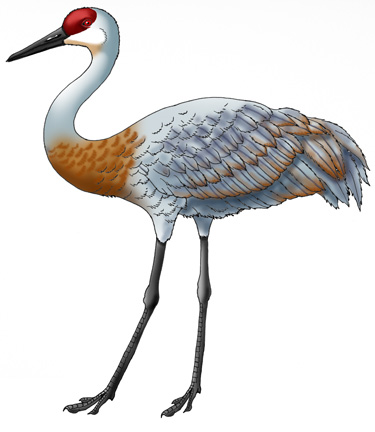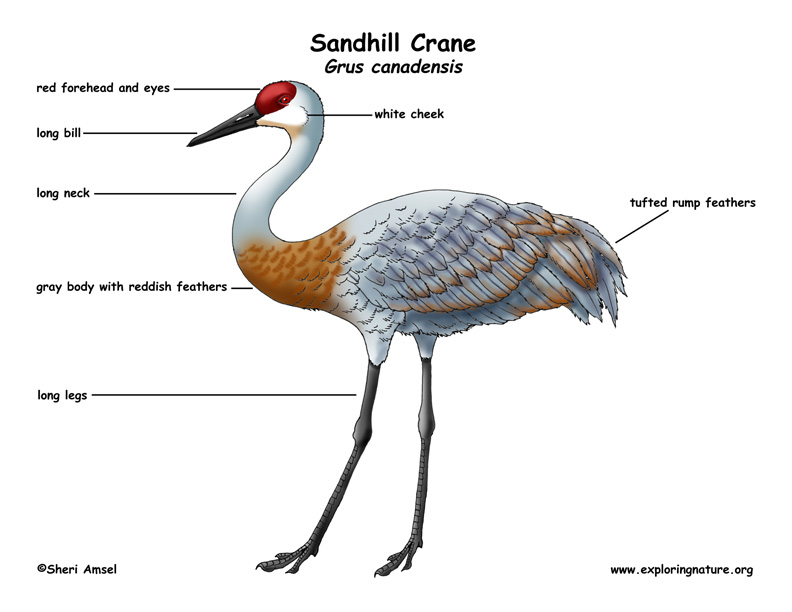

Sandhill cranes summer in the Arctic, northeastern Siberia, and Canada down through the U.S. with concentrations in the Sandhills of Nebraska, the Rockies, and Great Lakes region. They winter in California and the southern states through northern Mexico and can be found year round in Cub and Florida.
They live in wetlands, breeding in marshes and bogs and feeding in wet meadows and farm fields.
These cranes are very large birds with a long neck and very long legs. They have a red forehead and eyes, a white cheek and gray neck. They have a long, dark, pointed beak. Their body is gray to dirty yellow (ochre) over all a reddish cast to some body feathers and on the lower neck (especially in younger birds). They have a large tuft of feathers for a tail. Males weigh up to 15 pounds (7 kg) but average closer to 10 pounds. Females are smaller. They can reach almost 4 feet tall, but average less.
Sandhill cranes stay with their mates and newest young throughout the year. If not mated, they will migrate, feed and roost in groups. They have a loud, buzzing call that mated pairs often do together. They migrate south in winter flying with their necks out straight. This compared to the crook in the flying great blue heron.
They mostly eat seeds (and agricultural grains and fruits), but also take some insects, spiders, snails, frogs, lizards and even small mammals. Their natural feeding habitats are wetlands, but they have adapted to human site and now gather in farm fields probing the ground to find grain.
They build a nest of plant matter collected into a large mound and floating in a marsh, bog or other wet habitat. Both parents help build the nest, raise the young and stay together throughout the year. The female lays 1-3 light brown eggs with darker splotches which both parents incubate for about a month. Hatchlings are able to peck at seeds almost right away (within a day or two) but the parents will feed them for several weeks. As they grow the chicks will stay with their parents in a family group through their first migrations and until the next breeding year when they join other sub-adult cranes.
They can live up to 20 years in the wild. They are not endangered overall, but are rarer in their southern range.
Kingdom: Animalia
Phylum: Chordata
Subphylum: Vertebrata
Class: Aves
Order: Gruiformes
Family: Gruidae
Genus: Grus
Species: G. canadensis
When you research information you must cite the reference. Citing for websites is different from citing from books, magazines and periodicals. The style of citing shown here is from the MLA Style Citations (Modern Language Association).
When citing a WEBSITE the general format is as follows.
Author Last Name, First Name(s). "Title: Subtitle of Part of Web Page, if appropriate." Title: Subtitle: Section of Page if appropriate. Sponsoring/Publishing Agency, If Given. Additional significant descriptive information. Date of Electronic Publication or other Date, such as Last Updated. Day Month Year of access < URL >.
Amsel, Sheri. "Crane (Sandhill)" Exploring Nature Educational Resource ©2005-2024. December 14, 2024
< http://www.exploringnature.org/db/view/Crane-Sandhill >

